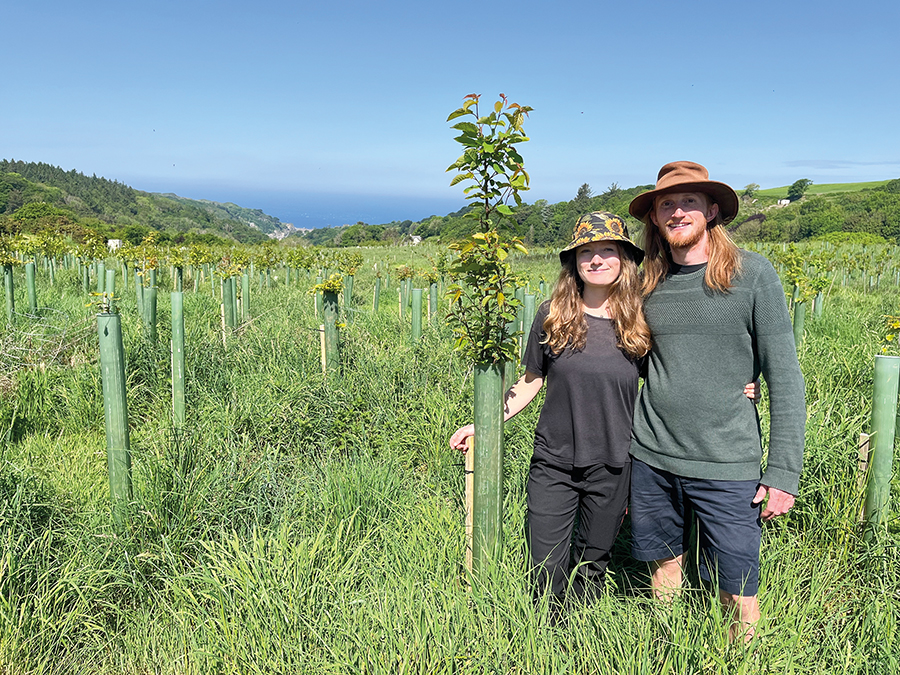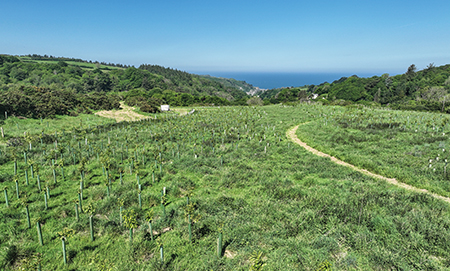New woodland boosts biodiversity and bolsters community spirit
4th July 2024
Landowners Phil and Chelsea had been looking for the perfect woodland to buy – but the MOREwoods scheme by the Woodland Trust enabled them to plant their own instead.

Set in a stunning coastal area just back from the cove at Lee Bay, North Devon, Phil Johncock and Chelsea Wills purchased the 4.3 acre area of predominantly permanent pasture in early 2021.
With a medium slope down towards the north and north-west boundaries, the plot also includes a strip of mature, semi-natural woodland on steep ground to the north.
“We had been looking originally for mature woodland, which has long been a dream of mine,” explains Phil. “I’m a woodworker and have managed woodland in Kent, and my goal has always been to move into natural building work.”
With Chelsea intending to set up a ‘yoga in the woods’ venture, the couple’s love of trees is clear. Wanting to do their bit for conservation and biodiversity, they had been looking for established woodland to purchase for quite a while, but had been unsuccessful in finding anything locally that they could afford.
“Then, when we’d all but given up, a couple of people came up to us in the village, and asked if we’d purchased any of the local woodland that was up for sale,” Phil says. “We were completely unaware that there was any, so looked up the details that evening, and put in an offer straightway, without having even set foot on the plot!”
While there was some existing woodland, there was also plenty of space to plant more trees – which, in hindsight, has provided the couple with a higher level of satisfaction than they could have hoped for.
“This way, we could create our own space, have some say in what trees would go into the land, as Phil in particular is very passionate about native species, and make our own long-term impact on the local environment,” shares Chelsea.
Getting started
Keen to get started on their planting vision as soon as possible, but with a limited budget to work with, Phil and Chelsea began eagerly researching subsidy options.
“I had previously applied for a MOREhedges grant for some land in Kent, so was already aware of the MOREwoods scheme,” explains Phil. “So for me, it was between the Forestry Commission scheme, which would have funded the planting completely, or MOREwoods, which funded 75%.
“However, after starting the process with both options, we found the Forestry Commission application to be incredibly time consuming and complicated, whereas the MOREwoods application was far more user-friendly and much less paperwork heavy.”
Phil and Chelsea are also massive supporters of the general ethos behind the Woodland Trust – their landlady, Heather, was involved in the original setting up of the Trust, supporting founder Kenneth Watkins OBE, who was a retired farmer and agricultural machinery producer. Thanks to Heather, they were already well versed in the vision of the Trust, and felt it really aligned with what they wanted to do. “For us, with our connection to Heather, it felt as though working with the Woodland Trust meant completing the circle that she started all those years ago,” smiles Phil.
Working with neighbours
Not long after purchasing the plot, Phil and Chelsea got in touch with fellow landowners, Craig and Debs, who had bought the neighbouring land with the intention of upholding Craig’s late father’s will wishes – to use the money to better the lives and education of future generations.
“This perfectly matched with our hope to open the space up to the local community,” explains Phil.
So, through the shared ideals and enthusiasm for woodland creation, the four of them very quickly became friends and helped each other through the various obstacles and decision making process – linking up their MOREwoods applications and helping both couples to get the most out of the scheme.
Shortly after submitting the application, they received a response accepting the proposal. “The Woodland Trust then arranged for a very knowledgeable chap called Iain to make a site visit,” Phil says. “Iain offered lots of advice, and I was able to bounce ideas off him and explain what Chelsea, Debs, Craig and I were envisaging.”
Iain explained what was available from the plant nursery offered by MOREwoods, and was the intermediary between Phil’s ‘dream’ plan and what was actually practical and realistic.
“The process was really streamlined, with it only taking around six months from initial application, to the trees being delivered,” comments Phil.
Another benefit of the combined applications was that the trees were all delivered at the same time, which reduced the environmental impact from a logistics point of view, with fewer deliveries required.
The planting plan
The aspect of the land means that one of the most important considerations when it came to the planting plan was providing shelter – particularly as Chelsea is intending to use the land for yoga as a business diversification.
“We planted shelter belts, with Scots pine, silver birch, hornbeam, and non-native Italian alder (which was sourced externally to support the growth of the other trees) helping to provide protection from the prevailing wind,” explains Chelsea.

For Phil’s woodworking business, being able to source his own materials from the land, with which he can teach spoon whittling and other woodworking skills, was very important to him from a sustainability perspective.
The species planted are a broad mix of native broadleaf for diversity, and specific species suitable for coppicing at a high density formed from a core of sweet chestnut, with oak, hornbeam, rowan and hazel.
“None of us wanted a hard border; instead deciding to plant small and large-leaved limes from a local supplier at points along the boundary,” Phil says. “We then took this one step further and linked up paths and copses to create a flowing, larger interconnected woodland which retains the view of the bay, so a ride was created on the land to allow this.”
“I was and still am rather fanatical about our native and lesser-known trees and shrubs, so encouraged Craig and Debs to join us in planting a broad range of species, such as alder buckthorn and wild service trees, which the Woodland Trust was fantastic in supporting us with,” points out Phil.
This kind of landscape scale approach makes the MOREwoods planting scheme so much more impactful in term of wildlife and habitat creation.
Planting the trees
The planting effort of the c. 2,500 trees saw the involvement of nearly 50 friends, family and local residents, and took place between 24th and 28th November 2021 – during Storm Arwen. “Call us mad, but everything had been organised ahead of time, with loads of volunteers ready and food arranged, so we felt it would have been a real shame if we’d cancelled it due to the weather,” says Chelsea.
Phil adds: “It was great to invite locals in to help – firstly, it helped them to understand who we are and what we’re trying to do, which for us was particularly important for those over-looking the planting land. Plus, it also allowed them to invest in the woodland, and they hopefully will now have a sense of ‘we planted that tree’ which will echo down the generations.”
Managing the young woodland
During the drought of 2022, during which Phil and Chelsea had very few options for irrigation, some of the trees (particularly some hawthorn, which are naturally thirsty and which were planted on a well-drained, rocky ridge) were lost, as well as some Scots pine, as they typically don’t like being transplanted – but Phil says more than 90% of the trees have survived, and thrived. “Before planting, we dipped the roots of the trees in mycorrhizal fungi in order to help support them and create a secondary root system from an early age.”
In fact, the trees have dealt well with all extremes of weather, and have also made a significant impact on the water balance within the land – even at such an early stage.
“Before we planted the trees, I remember there being a lot of water pooling on the surface of the field, with the upper meadow being quite boggy and marshy,” comments Chelsea. In other areas, a high level of water run-off impacted the soil surface, with soil erosion being a concern.
The couple added in native alder in the most affected areas, and since then haven’t noticed any pooling or overly wet soils. “We can only assume the water is now being stored below ground, released slowly and used efficiently by the trees,” explains Chelsea.
Management-wise, Phil says you can put in as much effort as you want – but the more you do, the greater the reward. “Initially, our time was taken up removing grass from the base of the trees,” he says. To keep on top of this, they contacted a few local tree surgeons to ask for donations of woodchip, which the couple use to mulch around the base of the trees and suppress some of the grass.
Looking further ahead, the oak and some sweet chestnut can be grown on as standards and the rest coppiced on a 15–20-year rotation, or can all be cut as coppice on the same rotation.
Whilst establishing, the coppice species can be cut early to start the formation of coppice stools. This can be done after 6–7 years if good growth is being achieved, or left longer if necessary, with the area having to be temporarily deer fenced until regrowth is established.
Of course, in addition to supplying Phil with a supply of sustainable wood for his business, the trees also have the potential to provide fuel, as well as aiding in the quest to capture and lock-up carbon.
The trees are now growing out of their tree guards, and the woodlands are really taking shape. Glade clearings give the opportunity for Chelsea to pursue her plan to teach outdoor yoga in the near future – a diversification of the land which would otherwise not have been possible without the new woodland.
Boosting biodiversity
The young trees are already providing natural shelter to wildlife – something which would have provided a benefit to livestock on the previously grazed land, and which can easily do so again if the parcel is ever returned to farmland.
An increase in barn owls and other predatory birds has also been noted – along with beneficial insects, proving that the trees are already boosting biodiversity and bringing more health and natural balance to the soil and local environment.
Making it possible
The 75% subsidy had a massive impact when it came to being able to undertake the tree planting, Phil says. “Otherwise, we would have had to do it a small section at a time, which would have had an impact on the amount of time it would have taken to get the end result that we hoped for. If we’d rewilded it naturally, and let the trees just do their thing, the wildlife population would probably have eaten the young trees before they had a chance to establish.”
So, if they had the land and opportunity to do it again, would they? “Absolutely!” is Phil’s emphatic response. “We would definitely urge other landowners to do it too,” adds Chelsea. “MOREwoods made it possible this time, and we’d apply again, given the chance – plus, next time we’d be armed with the fantastic knowledge we’ve learned this time around.”
MOREwoods is funded by Lloyds Bank to support sustainable farming.
Read more arable news




